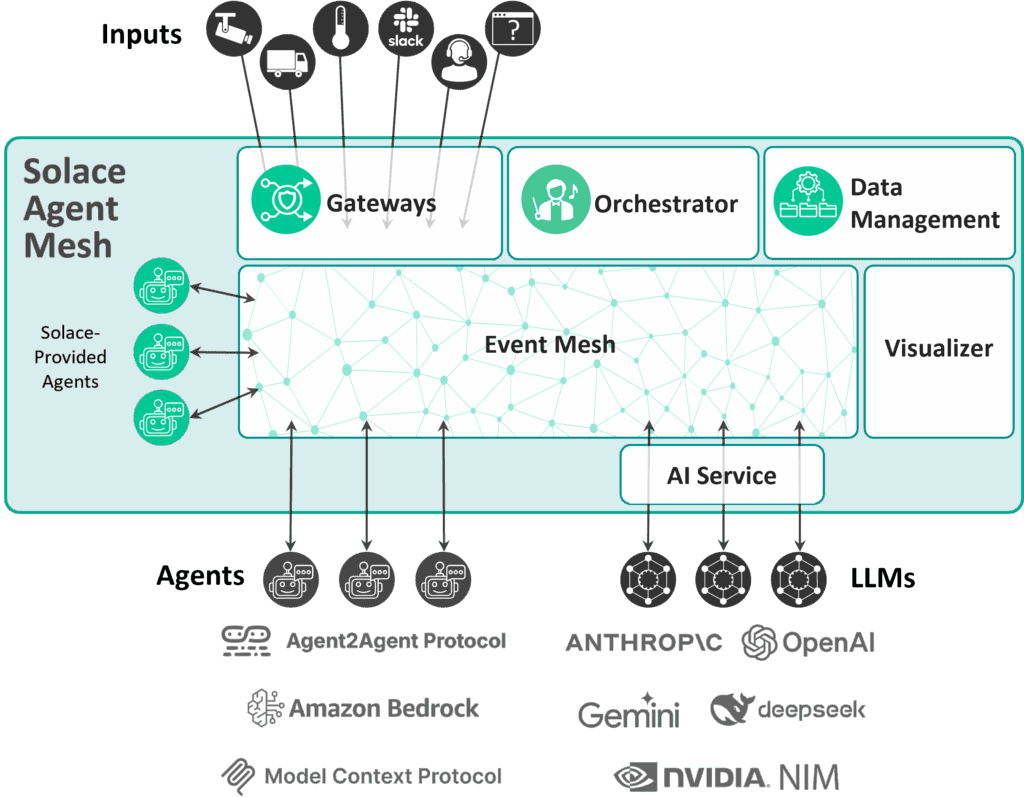Home > Blog > Artificial Intelligence
Subscribe to Our Blog
Get the latest trends, solutions, and insights into the event-driven future every week.
Thanks for subscribing.
Organizations seeking to implement AI today face a fundamental challenge: while powerful AI models are readily available, connecting them to enterprise data and systems where they can deliver value remains complex. This integration challenge—not the AI models themselves—is the primary roadblock to successful enterprise AI adoption.
The 80/20 Rule of Enterprise AI
From our work with enterprise customers, we’ve observed a consistent pattern: roughly 20% of the challenges in AI projects relate to the AI technology itself, while 80% involve integration with data sources across the enterprise. Data exists in silos across databases, SaaS platforms, custom applications, and legacy systems, and across multiple clouds and geos, making it exceedingly difficult to build AI applications that operate seamlessly across these boundaries.
To address this challenge, we’re excited to introduce Solace Agent Mesh—an open platform where agents with special skills and enterprise data sources come together to build highly scalable, reliable and secure AI workflows and applications. At its core, Solace Agent Mesh orchestrates AI agents by decomposing bigger jobs into smaller tasks, planning and distributing those tasks among multiple AI agents & tools, and helping them get the job done reliably and securely.
AI-Generated Podcast
For fun I asked Google’s awesome NotebookLM to spin up a simulated podcast about Solace Agent Mesh — give it a listen!
What Makes Solace Agent Mesh Different
While other agentic frameworks exist, Solace Agent Mesh stands apart through its comprehensive integration platform and enterprise-grade foundation. Here’s what truly sets it apart:
Fully Open Integration Platform
Solace Agent Mesh isn’t just a standalone agentic framework – it comes together with the Solace platform that combines agents’ orchestration with micro-integrations and the Solace event mesh. This architectural approach enables unprecedented flexibility to integrate with:
- Other agentic frameworks through open protocol using a simple event driven paradigm
- Diverse enterprise data sources and applications
- Various LLM providers and AI services
- Emerging agentic and tools protocols such as Anthropic’s Model Context Protocol (MCP) and Google’s Agent-to-Agent (A2A) interoperability protocol.
Unlike solutions that lock you into specific technologies and strive to keep you on their siloed platforms, Solace Agent Mesh lets you build exactly what you need while leveraging your existing investments.
Real-Time Event-Driven Architecture
While other frameworks might claim to be event-driven, Solace Agent Mesh is built on Solace Event Broker — a smart broker with nearly two decades of deployment in mission-critical environments. This foundation enables:
- AI workflows triggered by real-time enterprise events
- Access to up-to-the-second data context for more accurate decisions
- Immediate propagation of insights back to business systems
- Elimination of stale data that leads to inaccurate AI responses
This real-time capability fundamentally transforms how AI interacts with your business operations asynchronously, moving from batch-processing to continuous intelligence.
Advanced Data Management
Solace Agent Mesh takes a radically different approach to managing data between enterprise systems and AI models. For example, rather than pushing entire datasets into LLMs, it only sends the necessary data to LLMs and performs data manipulations outside the LLMs. This approach:
- Improves the performance and response time to the users
- Makes data-driven responses deterministic
- Reduces the risk of hallucination
- And significantly reduces token usage and therefore lowers costs
Learn more about Solace Agent Mesh’s advanced data management capabilities.
Enterprise-Grade
While many existing frameworks are well-suited for experimentation or research purposes and do well in the POC and pilot phases, enterprises are struggling going from that phase to production. Solace Agent Mesh is built from the ground up for enterprise-grade production deployment:
- Two-tier security: 1) fine-grain access control to agents and actions 2) delegated access to the enterprise data sources and services
- Inherent scalability through asynchronous communication using a battle-tested event broker technology at its core
- Horizontal scaling of both agents and orchestrators
- Resiliency to inherently unreliable infrastructure which can result in an agent’s outage
- Comprehensive monitoring and observability
This foundation ensures your AI initiatives can move confidently from prototype to production without architectural overhauls.
Components and Capabilities
Solace Agent Mesh consists of several key components, shown here and described below.
Event Mesh
The communication backbone that decouples systems and enables reliable real-time messaging between all components. This is what allows for agent horizontal scaling, dealing with speed mismatches, failures and retries, providing transparent observability and all the other positive properties of event driven microservices.
Orchestrator
The orchestrator maintains a registry of agents and their capabilities, decomposes requests into tasks, uses either dynamic or prescriptive workflows to achieve the end goals by assigning the right task to the right agent, and controls access to agents based on authorization scopes.
Gateways
Gateways define the system’s personality and control access to the agent ecosystem through different interfaces (browser, Slack, Teams, REST API, etc.). In addition, they provide fine-grain security control limiting access to both agents as a whole or their specific actions if necessary. Gateways are the component that allows us to say, Agent Mesh is not yet another chatbot by allowing one to access automated agentic workflows and processes using incoming REST API calls or events.
Agents
Agents are like employees of the system with specialized skills which we call actions. They are processing units, typically with access to LLMs, that perform specific tasks or provide domain-specific knowledge. Agents can be integrated with various data sources, tools, or services. Think of them as components that follow event-driven microservices architecture pattern. The event-based interface and communication allows these agents to be written by any team and in any language in your organizations. They are fully decoupled and run independently from the rest of the system. In addition, our support for Model Context Protocol makes the agents event more extensible and powerful in integration with existing enterprise systems.
AI Service
The AI Service provides centralized access to AI models (LLMs, embeddings, image processing) through a purpose-based approach, allowing components to request AI capabilities by function or intent rather than specific model names. As an example, reasoning could be an intent and when that intent is used the traffic can be routed to a reasoning model automatically. This decoupling enables seamless model upgrades (e.g., when new and better reasoning models are available), load distribution, as well as centralized access control and governance to the right model.
Data Management
Solace Agent Mesh includes a file service and file managers to mediate between enterprise data sources and AI models, so only necessary data is sent to LLMs. This is achieved by:
- Passing the data schema and educating the LLM on available data
- Enabling LLMs to request & reference precise data subsets through dynamic queries with advanced filtering capabilities
- Allowing LLMs to perform data manipulations and analytical aggregations outside the LLMs by generating and sending back the right queries to the system.
Sending a lot of data to LLMs, which are prediction machines, and expecting them to perform analysis can result in inaccurate results, and hallucination. Data management eliminates the need for roundtrip data to LLM and therefore increases performance, makes the results accurate, and reduces the cost.
Visualizer
The Solace Agent Mesh CLI includes a built-in visualizer, which provides an interactive web-based UI. This visualizer allows you to track the complete lifecycle of a stimulus (request) as it moves through the system, and monitor all registered agents and their activity in real-time.
Real-World Applications
Organizations are already leveraging Solace Agent Mesh in various ways including in the following scenarios:
- Real-Time Operational Intelligence & Analytics: Creating an AI layer on top of operational systems such as order management or inventory management that allows for natural language querying against those systems, rendering visualizations and dashboards, finding issues and root causes, unusual patterns, and resolving issues.
- Customer Support Enhancement: Integrating Solace Agent Mesh with CRM systems to provide service representatives with real-time customer insights, enhance ticket context and recommendations for resolutions, summarization, and AI-based CSAT scores.
- Knowledge Management & onboarding: Building enterprise knowledge platforms that can access, analyze, and synthesize information across organizational silos and help onboard the employees to the new system.
- Employee Offboarding Automation: transforming manual offboarding processes by responding to termination events with orchestrated multi-agent workflows spanning IT, finance, and facilities. This event-driven approach ensures consistent execution of offboarding tasks, timely access revocation, proper knowledge transfer, and exit interview while eliminating manual checklists and reducing administrative overhead.
Customers who use Solace Agent Mesh have observed significant productivity improvements on specific tasks and learned patterns and issues in their operational data that they didn’t know existed. This of course has resulted in efficiency and better customer experience.
The Path Forward
The AI landscape will continue evolving rapidly, but one constant remains: the need for robust, scalable integration between AI technologies and enterprise systems. By building on event-driven architecture principles, Solace Agent Mesh provides a foundation that can adapt to changing AI capabilities while maintaining the reliability, security, and governance that enterprises require.
As your organization navigates its AI journey, consider whether your current approach to AI integration will scale with your ambitions. Solace Agent Mesh offers a proven path forward, combining the innovation potential of modern AI with the enterprise-grade foundation needed for production success.
We encourage you to try out the open source community edition of Solace Agent Mesh on GitHub, or contact us to set up a 1:1 demo!
Explore other posts from category: Artificial Intelligence

Ali Pourshahid is Solace's chief engineering officer, leading the engineering teams at Solace. Ali is responsible for the delivery and operation of software and cloud services at Solace, and works closely with product management on product strategy. He leads a team of incredibly talented engineers, architects, and user experience designers in this endeavor. Since joining, he's been a significant force behind Solace Cloud, Solace Event Portal, and Solace Insights products. He also played an essential role in evolving Solace's engineering methods, processes, and technology direction. Most recently, Ali has played a pivotal role in shaping and driving the company’s AI strategy, products, and adoption.
Before Solace, Ali worked at IBM and Klipfolio, building engineering teams and bringing several enterprise and cloud-native SaaS products to the market. He enjoys system design, building teams, refining processes, and focusing on great developer and product experiences. He has extensive experience in building agile product-led teams.
Ali earned his Ph.D. in Computer Science from the University of Ottawa, where he researched and developed ways to improve processes automatically. He has several cited publications and patents and was recognized as a Master Inventor at IBM.


Subscribe to Our Blog
Get the latest trends, solutions, and insights into the event-driven future every week.
Thanks for subscribing.

